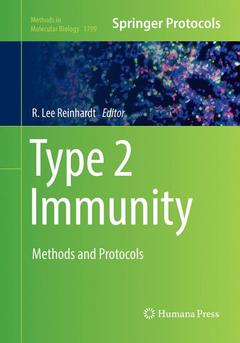Description
Type 2 Immunity, 1st ed. 2018
Methods and Protocols
Methods in Molecular Biology Series, Vol. 1799
Language: English
Subject for Type 2 Immunity:
Keywords
Publication date: 12-2019
434 p. · 17.8x25.4 cm · Paperback
Publication date: 06-2018
434 p. · 17.8x25.4 cm · Hardback
Description
/li>Contents
/li>Comment
/li>
This book provides researchers the opportunity to investigate type-2-associated diseases in their laboratories. Beginning with chapters describing various models of type-2 immunity, the volume then continues by detailing cellular protocols designed to identify, characterize, and assess the function of key adaptive and innate immune cells involved in type-2 inflammation; approaches to isolate and evaluate specific cellular subsets at the genetic, epigenetic, and molecular level; protocols to assess type-2 immunity and its relationship to organismal and metabolic systems (ex. Microbiome). This book concludes with a section that explores the use of primary human cells in evaluating relevance to the clinic. Written in the highly successful Methods in Molecular Biology series format, chapters include introductions to their respective topics, lists of the necessary materials and reagents, step-by-step, readily reproducible laboratory protocols, and tips on troubleshooting and avoiding known pitfalls.
Vital and authoritative, Type 2 Immunity: Methods and Protocols aims to provide a broad network of methods that can be used to develop a hypothesis and investigate its potential from bench to beside.
1. A Fungal Protease Model To Interrogate Allergic Lung Immunity
J. Morgan Knight, Evan Li, Hui-Ying Tung, Cameron Landers, Jake Wheeler, Farrah Kheradmand, and David B Corry
2. Use of the Litomosoides sigmodontis Infection Model of Filariasis to study Type 2 Immunity
Fulton, A., Babayan, S. A., and Taylor, M. D.
3. Production of Hymenolepis diminuta in the Laboratory: An Old Research Tool With New Clinical Applications
Min Zhang, Amanda J. Mathew, and William Parker
4. A Mouse Model of Peanut Allergy Induced By Sensitization through the Gastrointestinal Tract
Kelly Orgel and Michael Kulis
5. Induction and Characterization of the Allergic Eye Disease Mouse Model
Nancy J. Reyes, Rose Mathew, and Daniel R. Saban
6. Isolation and Purification of Epithelial and Endothelial Cells from Mouse Lung
Hideki Nakano, Keiko Nakano, and Donald N. Cook
7. In vitro and In vivo IgE/Antigen Mediated Mast Cell Activation
Hae Woong Choi and Soman N. Abraham
8. The use of Human and Mouse Mast Cell and Basophil Cultures to Assess
type-2 Inflammation
Heather L. Caslin, Marcela T. Taruselli, Anuya Paranjape, Kasalina Kiwanuka, Tamara Haque, Alena P. Chumanevich, Carole A. Oskeritzian, and John J. Ryan
9. Isolation and Identification of Group 2 Innate Lymphoid Cells in Settings of Type 2 Inflammation
Jesse Charles Nussbaum and Jorge Felipe Ortiz-Carpena
10. Determination of the Fate and Function of Innate Lymphoid Cells Following Adoptive Transfer of Innate Lymphoid Cell Precursors
Timothy E. O’Sullivan and Joseph C. Sun
11. Characterization of Thymic Development of Natural Killer T Cell Subsets by Multiparameter Flow Cytometry
Kathryn D. Tuttle and Laurent Gapin
12. Characterization of Mouse gd T Cell Subsets in the Setting of type-2 Immunity
Wanjiang Zeng, Rebecca L. O'Brien, Willi K. Born, and Yafei Huang
13. The Identification of Allergen-derived T cell Epitopes
Véronique Schulten and Alessandro Sette
14. Generation of Allergen-specific Tetramers for a Murine Model of Airway Inflammation
James J. Moon and Marion Pepper
15. The Generation and Use of Allergen-specific TCR Transgenic Animals Manon Vanheerswynghels, Wendy Toussaint, Martijn Schuijs, Leen Vanhoutte, Nigel Killeen, Hamida Hammad,andBart N. Lambrecht
16. Using Cytokine Reporter Mice to Visualize Type-2 immunity in vivo
Mark Dell’Aringa and R. Lee Reinhardt
17. Live Imaging of IL-4 expressing T Follicular Helper Cells in Explanted Lymph Nodes
Mark Dell’Aringa, R. Lee Reinhardt,Rachel S. Friedman, and Jordan Jacobelli
18. Imaging Precision Cut Lung Slices to Visualize Leukocyte Localization and Trafficking
Miranda R. Lyons-Cohen, Hideki Nakano, Seddon Y. Thomas, and Donald N. Cook
19. Study of IgE-producing B cells using the Verigem Fluorescent Reporter Mouse
Zhiyong Yang, James B. Jung, and Christopher D. C. Allen
20. Chromatin Preparation from Murine Eosinophils for Genome-wide Analyses
Carine Bouffi, Artem Barski, and Patricia C. Fulkerson
21. A Sensitive and Integrated Approach to Profile Messenger RNA from Samples with Low Cell Numbers
Sandy Lisette Rosales, Shu Liang, Isaac Engel, Benjamin Joachim Schmiedel, Mitchell
Kronenberg, Pandurangan Vijayanand, and Grégory Seumois
22. An Integrated and Semi-automated Micro-scaled Approach to Profile Cis-Regulatory Elements by Histone Modification ChIP-Seq for Large-scale Epigenetic Studies
Diana Youhanna Jankeel, Justin Cayford, Benjamin Joachim Schmiedel, Pandurangan Vijayanand, and Grégory Seumois
23. Library preparation for ATAC-sequencing of Mouse CD4+ T Cells Isolated from the Lung and Lymph Nodes after Helminth Infection
Laura D. Harmacek, Preeyam Patel, Rachel Woolaver, R. Lee Reinhardt, and Brian P. O’Connor
24. Identification of Functionally-relevant microRNAs in the Regulation of Allergic Inflammation
Marlys S. Fassett, Heather H. Pua, Laura J. Simpson, David F. Steiner, and K. Mark Ansel
25. The Use of Biodegradable Nanoparticles for Tolerogenic Therapy of Allergic Inflammation
Charles B. Smarr and Stephen D. Miller
26. Assessing the Mouse Intestinal Microbiota in Settings of type-2 Immune Responses
Mei San Tang, Rowann Bowcutt, and P’ng Loke27. The use of CRISPR-Cas9 Technology to Reveal Important Aspects of Human Airway Biology
Azzeddine Dakhama and Hong Wei Chu
28. A Consistent Method to Identify and Isolate Mononuclear Phagocytes from Human Lung and Lymph Nodes
Sophie L. Gibbingsand Claudia V. Jakubzick
29. Organoid Cultures for Assessing Intestinal Epithelial Differentiation and Function in Response to Type-2 Inflammation
Bailey Zwarycz, Adam D Gracz, and Scott T Magness
30. Utilization of Air-liquid Interface Cultures as an in vitro Model to Assess Primary Airway Epithelial Cell Responses to the Type 2 Cytokine Interleukin 13
Jamie L. Everman, Cydney Rios, and Max A. Seibold
Includes cutting-edge methods and protocols
Provides step-by-step detail essential for reproducible results
Contains key notes and implementation advice from the experts




